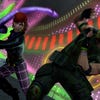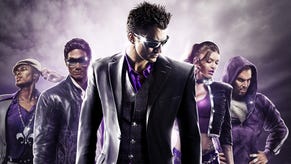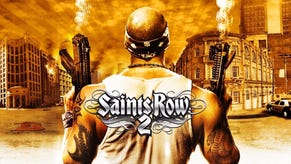Saints Row: The Third Review
The lulz before the storm.
Grand Theft Auto 4 was the best thing that ever happened to Saints Row. When it originally launched, THQ's open-world rival was little more than a cheeky copycat, offering the same transgressive thrills in a cruder, cheaper form; the Zit to GTA's more successful Viz.
Then GTA4 came along, and with it a sharp detour from the sort of knockabout nihilism that had typified the series. In the midst of Niko Bellic's downbeat immigrant saga, going on a rocket launcher rampage seemed a little weird, and Saints Row 2 was quick to position itself as the gleefully silly sandbox game that still let you smash your toys until something broke. If GTA was aiming for high drama and critical acclaim, Saints Row was happy to fly the flag for those playing "for the lulz".
And so comes Saints Row: The Third, a game that has been marketed almost exclusively on the basis of all the wacky stuff it will let you do, silly costumes, sex toy weaponry, ragdoll mayhem and all.
The game gets off to a promising start, opening with the 3rd Street Saints on top of the world following the events of the previous game. The gang are global celebrities with a sideline in merchandise and a movie in the works.
The opening missions find you pulling a bank job teamed up with a preening method actor who wants to get "in character" for the Saints film. Things go spectacularly awry, leading to a series of impressive standalone action segments, the result of which leaves the Saints exiled from their home turf of Stilwater and forced to start over in the Detroit-meets-New York city of Steelport.
So from a premise that offers everything, the game wastes little time in reducing you to nothing, forced to fight for turf, battle rival gangs and generally climb the exact same ladder you already scaled in the first two games. It's indicative of the game as a whole, which teases you with the prospect of wild and crazy sandbox gameplay before hurrying back to the comforting familiarity of the old GTA template at every opportunity.
You spend the first two acts out of three going through these motions. You steal cars, disrupt rival drug deals, deliver A to B, protect Character X while they do Y, escort the NPC to the marked spot. Tooling around in stolen cars, listening to rap, rock and eighties pop interspersed with comedy talk radio skits - we've been down this road too many times before, and the fact that you can do it as a 300lb transvestite clown may amuse for a few minutes, but does little to paper over the cracks in the formula. For those expecting the wacky hijinks promised by the trailers, the game gets off to a painfully predictable and repetitive start.
Even the activities, home to the more outlandish tasks in Saints Row 2, feel strangely sanitised and generic. Gone are the sewage-spewing trucks, blazing quad bikes and fan-flinging celebrity defence. The helicopter assaults, prostitute escorts and more obvious diversions have all been retained. Assassinations and car thefts are tucked away as standalone mission trees.
"Nobody comes to a Saints Row game expecting high wit, but environmental gags such as a café called Tits n' Grits or a sleazy hotel called Stikit Inn feel crude even by this series' gloriously lowbrow standards."
There only four new additions. Trailblazer has been completely revamped and now takes place in virtual reality, as you navigate a headache-inducing halfpipe while dodging firewalls (literally walls of fire). Guardian Angel draws inspiration from Will Ferrell's Talladega Nights, putting you in a car with a tiger and demanding that you drive fast enough to keep it from killing you. A fun idea, but virtually identical in gameplay to the existing Escort missions, swapping sex for a large predator.
Trafficking is equally bland, a drug delivery shoot-out that adds little. Prof. Genki's Super Ethical Reality Climax is perhaps the most promising, an arena-style shooting gallery that borrows a lot from Bizarre Creations' cult shooter The Club. It's fun, but not quite the zany madness suggested by the Genki-themed promotions.
On a purely technical level, there's not much evidence of growth either. Character animation is impressive, but the world itself is as plagued by texture and object pop-in as ever, while the game throws up its share of physics hiccups to snag you on scenery, lodge vehicles inside solid objects or simply make things vanish into thin air. Understandable, given the sheer weight of data being lugged around, but this is a genre in desperate need of a technical overhaul.
Saints Row: The Third distinguishes itself in other ways though. Gone is the old Respect system, which locked away story progress until you'd churned through enough bonus activities, turning the game's fun distractions into obligatory chores. Now, the story can be played through without interruption.
Respect is simply used as a form of XP, used to unlock upgrades and abilities. It gives the game a much smoother structure and ensures that there's always something to be working towards. Character upgrades start small - sprint for 25 per cent longer, carry 25 per cent more ammo for a certain weapon - but by the time you hit the level cap at rank 50 you're able to make yourself bulletproof, fireproof, able to fall from skyscrapers without taking damage and blessed with infinite ammo and no reloads for every weapon in the game.
In fact, pretty much everything in the game can be upgraded. Cars can be customised and toughened up with wheel spikes. Almost every gun, melee weapon and explosive can be ranked up three times, adding extra damage and fun features. And your gang expands with every level-up attained, turning your homies into killing machines every bit as fearsome as yourself.
"By the time the story comes to a close ... you'll have accrued a toybox full of cool gadgets, including flying motorbikes, sonic cannons that liquefy enemies and the Fart In a Jar, which makes people vomit profusely."
Ambient challenges, tracked through the "Saintsbook" app on your in-game phone, add even more deeply buried progression paths. Every time you drive into traffic, every time you shoot someone in the head or groin, every time you destroy a Smart car or murder a costumed mascot, you're inching towards long-form goals that deliver additional XP.
Thanks largely to this welcome layer of role-playing flexibility, the game is surprisingly easy. You're on an inexorable upward climb from the start, and at normal difficulty few of the missions or optional activities are particularly tough to beat. Victory is assumed, rather than earned, and experienced players will face few obstacles on their voyage to 100 per cent completion (which, in my case, took just under 40 hours).
It's the sluggish start that keeps holding the game back, as both plot and gameplay spin their wheels. The game is adding little to the predictable template at this stage, and the clichés start to wear thin. Nobody comes to a Saints Row game expecting high wit, but environmental gags such as a café called Tits n' Grits or a sleazy hotel called Stikit Inn feel crude even by this series' gloriously lowbrow standards.
The game's obsession with political incorrectness also steers it into ugly waters on more than one occasion. A mission called Trojan Whores finds you under siege from an army of prostitute assassins. Even within the heightened hyper-reality of Saints Row, as you gun down waves of women dressed in stockings and suspenders it feels like a step away from ironic sexism and closer to outright misogyny.
Another mission, not long after, tries to find the fun in sex trafficking, as you storm an enemy cargo boat with the aim of stealing the women being smuggled into the city. The women cower and scream as you open their shipping crates, and at the end you get the choice between delivering them back into slavery for a cash reward, or keep them for yourself. Opt for the latter and you unlock an Achievement called "Gotta Break Em In".
All typically crass, confrontational stuff, but where's the insanity that is supposedly the game's defining feature? That finally arrives in the third act, as traditional firearms give way to science-fiction hardware and the plot takes refreshing detours through horror and cyberpunk territory. By the time the story comes to a close, and provided you've spent your cash wisely, you'll have accrued a toybox full of cool gadgets, including flying motorbikes, sonic cannons that liquefy enemies and the Fart In a Jar, which makes people vomit profusely.
Sadly, the game never comes up with anything particularly inventive for you to do with these bizarre tools. It's presumably enough that you're able to romp about the city, using them for a laugh. And, fair enough, that is fun for a while, even if the mania is tempered with familiarity
That the game still offers an enjoyable drop-in co-op mode makes these surreal rampages even more entertaining, and you can now capture photographic evidence of your misdeeds and share it online. There's also a separate wave-based survival mode, entitled Whored Mode, somewhat inevitably. Is that enough? Competitive multiplayer modes have been omitted entirely this time around, so it'll have to do.
The biggest disappointment with Saints Row: The Third isn't that it gets anything terribly wrong, but that it doesn't do more to distinguish itself from the genre it so brazenly copied to begin with. There's so much that can be done with the open-world idea, and there was an opportunity here to ditch the tired old gangster tropes and twist the freedom that a virtual city offers into something truly memorable and weird. Instead, we get another game defined by its adherence to the GTA formula, distinguished mainly by its funny costumes and enjoyably daft toys. Amusing, but hardly the mind-boggling insanity we were promised.
2011 has very much been the year of playing it safe as far as blockbuster threequels are concerned, but in a sandbox sold on the prospect of crazed excess, the world itself needed to change and the things we do in that world needed to get more and more outrageous.
There are traces of that excess here, but they arrive too late and change the formula too little to really make a meaningful difference. It's still a cynical slice of dirty fun, but the most damning aspect of Saints Row: The Third is that where the all-important lulz are concerned, there's precious little here that you couldn't already do in Saints Row 2.










































